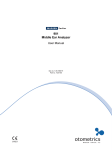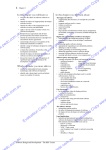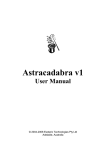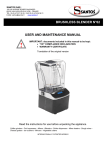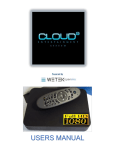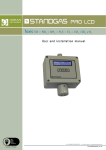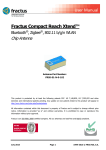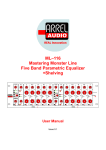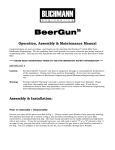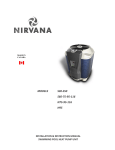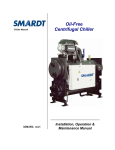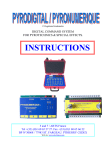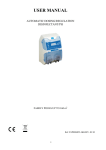Download Product waste disposal - Protection of the environment: In
Transcript
Product waste disposal - Protection of the environment: In accordance with the provisions of the Waste Electrical and Electronic Equipment (WEEE - 2002/96/EC) Directive, used electric and electronic products must be destroyed separately from normal household waste in order both to promote re-use, recycling and other forms of recovery and to reduce the quantity of waste to be destroyed and hence the disposal operations. When you dispose of this product, comply with the local waste disposal instructions. Do not throw it away in the middle of nowhere: take it to a waste collection centre that specialises in used electrical and electronic products and / or consult your dealer when buying a new product. 20 Contents 1 Description of your pH Perfect 1.1. Identification of parts 1.2. LCD screen and functions 2 Installation 2.1. Recommendations 2.2. Technical details 2.3. Installation diagram 2.4. Installing the control unit and electrical connections 2.5. Installing the pH sensor 3 Operating advice 3.1. Calibration procedure 3.2. Rule for injecting pH Perfect 4 Adjustments: “ Settings ” menu 4.1. Language 4.2. “Settings” menu - Default parameters 4.3. Set point 4.4. Type of dosage 4.5. “OFA” over-feed protection 4.6. Type of calibration 4.7. Detection that filtration is in progress 4.8. Resetting the appliance 5 Care and maintenance of your pH Perfect 5.1. Changing the peristaltic pipe 5.2. Winterizing the pH Perfect 6 7 22 22 23 24 24 24 25 26 27 28 28 30 31 31 31 31 32 32 33 33 33 34 34 35 Trouble - shooting guide 35 6.1. Alarms 6.2. Problem solving 35 36 Your guarantee 37 21 Congratulations, you are now the owner of a Zodiac pH Perfect, which allows you to regulate the pH of your pool simply and easily. The pH Perfect measures the pH value between 0.0 (acidic) and 14.0 (alkaline) using a pH sensor on the filtration system, which constantly analyzes the water in your pool. Depending on the value measured, the pH Perfect dosing pump injects the amount of product needed to maintain the balance of the water in the pool. The pH Perfect will function with either acid or alkaline dosing. 1 Description of your pH Perfect 1.1. Identification of parts The pack contains the items shown and required to install your pH Perfect: 1 2 3 7 5 6 9 8 10 11 4 12 22 1 pH Perfect controller 2 Wall bracket 3 2 x Stainless-steel screws and plugs (Ø = 6 mm) 4 Polyethylene inlet tube (5 metres) 5 Intake pipe with 2-metre PVC tube and 3-metre cable 6 FPM lipped injection flap valve (3/8") 7 pH Sensor with 5-metre shielded cable 8 Injection flap valve reducer 9 Sensor holder, model PSS3 (1/2”) 10 Collar for fixing the injection valve to DN 50 mm pipe 11 Collar for fixing the injection flap valve on tube DN 50 mm 12 pH calibration fluid kit 1.2. LCD screen and Functions 1 13 12 11 10 2 9 8 3 4 5 6 7 1 Backlighted LCD screen. 2 Peristaltic pump (1.5 L/h). 3 Connection for linking the semi-rigid polyethylene inlet tube (part# 4). 4 Connection for linking the PVC crystal intake pipe (part# 5). 5 Packing assembly: for passing the control cable directly to the filter (220-240V AC only when filtration is in progress). 6 Packing assembly: for passing the cable linking the unit to the intake pipe sensor (part# 5). 7 Packing assembly: for passing the 220-240V AC power cable. 8 BNC socket for connecting the pH sensor: (part# 7). 9 Master switch: for powering the control unit. 10 Navigation button “down”: for navigating in the “Settings” menu. 11 “SET/Esc” button: button for exiting from the “Settings” menu; also for displaying the pH set point when pressed continuously. 12 Navigation button “up”: for navigating in the “Settings” menu. 13 “CAL/Enter” button: button for enabling the sensor calibration mode (the button must be pressed for 5 seconds). This is also used for accepting changes in the “Settings” menu. 23 2 Installation 2.1. Recommendations ! Warning: The pH Perfect must be installed by an experienced pool professional. ➣ Should pH perfect require any electrical maintenance always disconnect the appliance from the power supply. ➣ Before installing the pH Perfect controller, make sure that you have all the components required and that you have read the instruction manual carefully. ➣ Failure to comply with the instructions contained in this manual can be dangerous, cause damage to the appliance and may void the warranty. ➣ While installing the pH Perfect controller, make sure of the following: – The supply voltage is as indicated on the label attached to the side of the appliance – The pressure at the injection point is less than 150 kpa – The protective housing on the pump is properly clipped into position – The suction tube is immersed with the intake pipe in the container of corrective solution to be injected and is connected to the pump (on the left). Then retighten the nut on the connector – The inlet tube will then be connected to both the pump (on the right), and the inlet pipe to the pool through the injection flap valve (part# 6). ➣ Use pH corrective products as recommended by your pool specialist. ➣ The pH sensor should be handled with care. 2.2. Technical details Dimension (L - W - H) Weight (appliance, sensor, tube and pipes) Power feed 50Hz Consumption Pump flow rate Maximum backpressure pH control range Appliance accuracy Calibration of the sensor 24 240 x 200 x 90 mm 1.7 kg 220-240 V AC 9W 1.5 l/h (or 25 ml/min) 150 kpa 0.0 pH-14.0 pH +/- 0.1 pH Semi-automatic in 2 points (1 point possible) 2.3. Installation diagram Installation of the pH Perfect on the filtration system 60 cm mini ! Important: The distance between the sensor and the injection point must not be less than 60 cm. The injection point must be the last element on the return line before the pool. Keep the sensor cable away from other power cords in order to prevent electrical interference. The maximum pressure in the pipes must not exceed 150 kpa. To increase the life span of the peristaltic pipe, the pressure should not exceed 100 kpa. If the pool has a chlorinator, a heating system or any other equipment, they must be situated after the pH sensor but before the acid injection point. 25 2.4. Installing the control unit and electrical connections Install the pH Perfect controller on a wall in an easily accessible place. Fix the wall bracket to the wall using the screws supplied and attach the pH Perfect. Before doing any work inside the appliance, make sure that the main switch is on position 0. By unscrewing the two screws on the right-hand side of the appliance by a 1/4 turn, the pH Perfect can be opened sideways. ! CAUTION: The electrical connections for the pH Perfect must be done by an experienced pool professional. “ Standard ” electrical connections for a pH Perfect 26 2.5. Installing the pH sensor ! Caution: The length of pipe between sensor and injection point must not be less than 60 cm. ➣ The sensor must be vertical, or at 45° max. and always above the pipe. In no circumstances should it be positioned horizontally or below the pipe. ➣ The sensor should be positioned before any treatment devices. Installation instructions Correct positions Incorrect positions 27 3 Operating advice 3.1. Calibration procedure Refer to paragraph 4.2. to change the language. ! Important: The sensor must be calibrated when your pH Perfect is first installed and ideally every two months there after. > Calibration must be done each time your pool is restarted at the beginning of the season. > The procedure should be repeated if an abnormal amount of corrective solution is consumed (pH minus or pH plus). > The calibration procedure can only be carried out when filtration is stopped. > Before calibrating, stop filtration and close the valves so as to isolate the pH sensor holder from flowing water. 1 > Fill flask n°2 with clean water (tap water). Figure 1. 4 2 > Undo the sensor holder and remove the sensor from the pipe. Figure 2. 5 a b > Immerse the sensor in flask n°1 (pH 7). Figure 4. 28 3 > Rinse the sensor in flask n°2 (water). Then shake gently to remove excess water. Figure 3. c > Keep the “CAL/Enter” button pressed for more than 5 seconds until “Calibration” appears on the LCD screen (Figure 5a). Press the “CAL/Enter” button again as indicated on the screen for calibration on pH7 (Figure 5b): an automatic progression bar then appears (Figure 5c). Keep the sensor immersed in the buffer solution for 30 seconds. 6 7 8 > After 30 seconds, the appliance again indicates the measurement reliability of the sensor expressed as a percentage. Figure 6. E.g.: 100 % with a new sensor; if < 25 %, see chapter 6.2. 9 a > Press the “CAL/Enter” button to go to calibration on pH4. Press the “CAL/Enter” button again as indicated on the screen Figure 9a. 11 > Rinse the sensor in flask n°2 (water). Then shake gently to remove excess water. Figure 7. b > Immerse the sensor in flask n°3 (pH 4). Figure 8. 10 > an automatic progression bar then appears. Figure 9b. Keep the sensor immersed in the buffer solution for 30 seconds. 12 > After 30 seconds, the appliance indicates the measurement reliability of the sensor expressed as a percentage. Figure 10. E.g.: 100 % with a new sensor; if < 25 %, see chapter 6.2. • When calibration is completed, your pH Perfect is ready to regulate the pH in your pool automatically. • If the pH in the pool is very far from the set point of the appliance (7.4 pH by default), pause the over-feed protection for 24 or 48 hours (see paragraph 4.5.). > Rinse the sensor in clean water, then shake gently to remove excess water and replace it in its sensor holder (it must not touch the pipe). Figure 11. > To finish calibration, press the “CAL” button. The instrument will return to measuring mode. Figure 12. • The pH Perfect peristaltic pump is self-starting. However, it is possible to operate it manually by keeping the “Navigation“up button pressed. The peristaltic pump will then inject corrective solution as long as the button is pressed. 29 3.2. Rule for injecting pH Perfect Proportional cyclic dosing - exclusive to Zodiac • To reach the set point in the best possible conditions (the quickest, but with the least possible corrective solution), your pH Perfect automatically detects the difference of the pH value measured in the pool compared with the desired set point (default value = 7.4 pH). • This proportional injection is cyclic and the cycle time is 10 minutes. What will change in dosing is the different times of injection and pause. • This type of dosing makes it possible to reach the set point quickly and precisely with the following advantages: – Optimal consumption of corrective solution (better balance of water, little action on the buffering capacity or TAC). – Water treatment functioning in the best conditions (the active chlorine is more effective with a good pH). Rule for injecting pH Perfect The proportions are adjusted automatically and the different dosages are distributed in steps of 0.15 pH. • E.g.: For 4 cycles with a set point of 7.4 pH and acid regulation (pH minus): – pH ≤ 7.55 : 20 % injection (2 minutes) & 80 % pause (8 minutes) – pH ≤ 7.70 : 50 % injection (5 minutes) & 50 % pause (5 minutes) – pH ≤ 7.85 : 75 % injection (7 minutes 30 secondes) & 25 % pause (2 minutes 30 secondes) – pH ≥ 7.90 : 100 % injection (10 minutes, continuous) Note: The rule for injecting is reversed if an alkaline dose is chosen. 30 4 Adjustments: “ Settings ” menu 4.1. Language A The default language displayed on the pH Perfect is French. Figure A. You can choose between 6 languages for the LCD display: French, English, German, Spanish, Italian and Dutch. To change language when in the “Settings” menu, enable the option list by pressing the “CAL/Enter” button (a small arrow appears on the right of the screen and the language message flashes). Then select the language using the “up” and “down” navigation buttons. Accept the choice by pressing the “CAL/Enter” button. 4.2. “ Settings ” menu - Default parameters ! The pH Perfect is factory preset with the following settings (suitable for most cases): a. Language: French b. Set point: pH = 7.4 c. Dosage = acid (injection when the pH is higher than the set point) d. “ OFA” over- feed protection: 240 minutes e. Calibration = enabled in 2 points (pH7 & pH4) f. Detection that filtration is in progress: enabled B However, there is an easily accessible “settings” menu for changing the settings of your appliance to match them as closely as possible to your pool's requirements. • To access the “Settings” menu, the appliance must be ON. Simultaneously press the “CAL/Enter” and “SET/Esc” buttons for about 5 seconds until the LCD screen displays “Settings”. Figure B. C This “settings” menu gives access to the following adjustments: – Language – Set point – Type of dosage – Time of using the “ OFA” over- feed protection – Type of calibration – Detection that filtration is in progress • To exit the “Settings” menu, press the “SET/Esc” button and select “Yes” or “No”, using the “up” and “down” navigation buttons to save the new settings or not. Accept the choice by pressing the “CAL/Enter” button. Figure C. 4.3. Set point D The default set point on the pH Perfect is 7.4 pH. To change it when in the “Settings” menu, enable the option list by pressing the “CAL/Enter” button (the pH value flashes). Then select the value chosen using the “up” and “down” navigation buttons. The adjustment is made in increments of 0.1 pH. Accept the choice by pressing the “CAL/Enter” button. Note: : It is also possible to directly access the set point by holding down the “SET/Esc” button (keep pressing while changing the setting). 31 E 4.4. Type of dosage The default dosage on the pH Perfect is acid (injection of pH minus). Figure E. To change it when in the “Settings” menu, enable the option list by pressing the “CAL/Enter” button (a small arrow appears on the right of the screen and the type of dosage flashes). Then select the dosage using the “up” and “down” navigation buttons. Accept the choice by pressing the “CAL/Enter” button. F 4.5. “ OFA ” over - feed protection Your pH Perfect is equipped with protection to prevent over-feeding with corrective solution in the event of a problem on the pH sensor, for example. The purpose of this protection, called “OFA” (Over Feed Alarm), is to pause the appliance if it has not reached the set point at the end of the time; set by default at 240 minutes. Figure F. The “OFA” over-feed protection functions in 2 steps: > #1: “ OFA alarm ” flashes on the LCD screen after 70 % of the OFA programmed time has been used without reaching the set point. However, the appliance continues running. > #2: “ Stop OFA” is displayed on the LCD screen after reaching 100 % of the OFA programmed time (240 minutes in the original setting). The appliance is then safe. • To cancel this protection and start your pH Perfect, press the “CAL/Enter” button (possible on the 2 steps of the OFA alarm). Note: Make sure that the pH sensor is in good condition. If necessary, clean and/or recalibrate it. • The over-feed protection is set by default for a maximum time of 240 minutes. It is possible to adjust it from “OFF” (disabled) to “240” by intervals of 1 minute. Note: A fairly high setting is strongly recommended to avoid any inopportune and/or unjustified start. • To regulate the OFA when in the “Settings” menu, enable the option list by pressing the “CAL/Enter” button (the value in minutes flashes). Then select the value chosen using the “up” and “down” navigation buttons. The adjustment is made by intervals of 1 minute. Accept the choice by pressing the “CAL/Enter” button. Special functions of the OFA To prevent “false” alarms just after installing a pH Perfect (if the pH is poorly balanced), the OFA may be temporarily disabled for 24 or 48 hours: > Press “up” & “down” & “CAL”: OFA disabled for 24 hours (automatically re-enabled). > Press “up” & “down” & “SET”: OFA disabled for 48 hours (automatically re-enabled). 32 G 4.6. Type of calibration Your pH Perfect is calibrated by default in 2 steps: pH7 and pH4. Figure G. This can be done in one single step on pH7 (faster but with lower measurement reliability over time). To change it when in the “Settings” menu, enable the option list by pressing the “CAL/Enter” button (a small arrow appears on the right of the screen and the type of calibration flashes). Then select the type chosen using the “up” and “down” navigation buttons. Accept the choice by pressing the “CAL/Enter” button. Note: If calibration is done in one step, the procedure described in paragraph 3.1. will automatically stop at the end of calibration with solution 7. 4.7. Detection that filtration is in progress Your pH Perfect is equipped by default with a double power feed for keeping the appliance live in order to calibrate the pH sensor when filtration is stopped. However, it is possible to disable this function if the electrical connection is different (work done by a professional). ! H Caution: The pH Perfect no longer takes into account whether filtration is in progress and is likely to inject corrective solution when there is no flow in the pipes. Disabling is only possible if the mains power cable is controlled by the filtration. To change this function when in the “Settings” menu, enable the option list by pressing the “CAL/Enter” button (a small arrow appears on the right of the screen and the status of detection of filtration flashes). Then select “ON” or “OFF” using the “up” and “down” navigation buttons. Figure H. Accept the choice by pressing the “CAL/Enter” button. 4.8. Resetting the appliance In the event of incorrect manipulation, it is possible to restore all the original pH Perfect functional settings. Procedure for resetting the pH > Switch OFF the appliance. > Switch ON the appliance by pressing simultaneously on the two “up” and “down” navigation buttons (keep the buttons pressed until the message appears on the screen). > Select “Yes” or “No” using the navigation buttons, then accept using the “CAL/Enter” button. > All the factory settings will then be restored. 33 5 Care and maintenance of your pH Perfect 5.1. Changing the peristaltic pipe 1 > Remove the protective cover carefully drawing it towards you. Figure 1. 4 > Position the tablet holder on “10:20” turning clockwise. Figure 4. 34 2 > Position the tablet holder on “10:20” turning clockwise. Figure 2. 5 > Insert the left-hand connection in its housing, then pass the tube under the guide of the tablet holder. Turn the tablet holder clockwise and at the same time put the tube into the pump head up to the right-hand connection. Figure 5. 3 > Fully release the left-hand connection keeping it stretched outwards, then turn the tablet holder clockwise in order to free the tube up to the right-hand connection. Figure 3. 6 > Replace the protective cover (place the pin in the attachment hole). Figure 6. 5.2. Winterizing the pH Perfect • When the regulator has to be winterized, it is advisable to pump clean water through it in order to rinse the peristaltic pipe. Then, position the tablet holder on “6:00” using the self-priming function and pressing the navigation button “up” (or by turning the tablet holder clockwise). These two precautions will make it easier to restart the appliance. • Remove the pH sensor from its holder. Store it in its original flask or a cup filled with tap water. If necessary plug sensor holder. ! 6 Note: never leave the end of the sensor out of water! Trouble-shooting guide 6.1. Alarms The left portion of the LCD screen on your pH Perfect displays various alarms (message flashing or fixed). This makes it easy to identify the problem. Alarm Cause Solution The container of corrective solution is empty • Replace the container • Make sure that the white float on the intake functions correctly First OFA step enabled (time > 70 %) • Press “CAL/Enter” to stop the alarm Second OFA step enabled (time = 100 %) • Press “CAL/Enter” to stop the alarm Filtration stopped • Start filtration • Check the connection Buffer solution ineffective PH sensor defective • Replace the buffer solutions • Clean and/or replace the pH sensor Parameter error • Press “CAL/Enter” to cancel the fault • Call your local pool professional 35 6.2. Problem solving Problem The pH Perfect always displays a pH near to 7.0 The appliance always displays a high value or the measurement is constantly unstable Cause Remedy Problem with cable and/or connector • Make sure that the sensor-pH Perfect connection is not short-circuited (between the central core of the cable and the exterior sheathing) • Make sure that there is no moisture and/or condensation around the BNC socket The electrode connection cable is damaged • Check the cable and/or the BNC socket The pH sensor has an air bubble in the bulb • Put the sensor into upright position and shake gently so that the air bubble rises back up to the top Note: The sensor should be fitted in a vertical position or at an angle no greater than 45° The pH sensor is worn • Replace the pH sensor The sensor cable is too close to a power cable causing interference • Reduce the distance between the appliance and the sensor and/or place the cable elsewhere • Make sure that the solution used is pH 7 Buffer solution is ineffective • Purchase a new pH 7 buffer solution and recalibrate again Impossible to calibrate on pH 7 (error message) Quality of calibration of the pH sensor < 25 % • Check the pH buffer solution with a pH electronic meter Problem with the sensor's porous element, dirt deposits • Make sure that the electrode bulb is in good condition, that it has not been allowed to dry out of the water. As a last resort, clean by soaking the electrode in a 10 % hydrochloric acid solution The pH sensor is worn • Replace the pH sensor • Make sure that the solution used is pH 4 Buffer solution is ineffective • Purchase a new pH 4 buffer solution and recalibrate again Impossible to calibrate on pH 4 (error message) Quality of calibration of the pH sensor < 25 % Slow response from the pH sensor 36 • Check the pH buffer solution with a pH electronic meter Problem with the sensor's porous element, dirt deposits • Make sure that the electrode bulb is in good condition, that it has not been allowed to dry out of the water. As a last resort, clean by soaking the electrode in a 10 % hydrochloric acid solution The pH sensor is worn • Replace the pH sensor Static electricity on the pH sensor • During the calibration phase DO NOT WIPE the pH sensor with a cloth or paper, but after rinsing, shake it gently 7 Your guarantee Conditions We have taken every care and applied all our technical experience in the production of this appliance. It has been subject to stringent quality controls. We make regular improvements and modifications to our models, which incorporate technological advances, therefore it must be clearly understood that such improvements cannot be added to earlier models under the guarantee. If, despite all the care and expertise in the manufacture of our products, you have to call on our guarantee, it will apply only to the replacement of defective parts. Transport costs in this instance, shall be borne by you the user. The guarantee is only valid if the appliance has been installed by a professional. Warranty period In Australia, South Africa and the United States of America, pH Perfect is guaranteed for 12mths (1yr) following the date of purchase excluding the replacement of worn parts due to normal operation of the product. Covered by the guarantee Only the control unit (PCB, pump motor and intake pipe) are covered by the guarantee period specified above. Any PCB found to be defective will be repaired or replaced by the manufacturer with a new part or a part in good working order. The following parts: the peristaltic pipe, buffer solutions, pH sensor and non-return valve are deemed consumable parts and therefore do not benefit from the guarantee period specified above. In all cases, the costs of travel and labour will be borne by the user. In the case of workshop returns, transport costs will be borne by the user and the cost of labour will be borne by the manufacturer. Damage in transport Appliances are always transported at the user's own risk. It is up to the user, before taking delivery of the appliance, to make sure that it is in perfect condition and, if necessary, to note any reserves on the carrier's delivery note. We cannot be held liable in this matter. 37



















